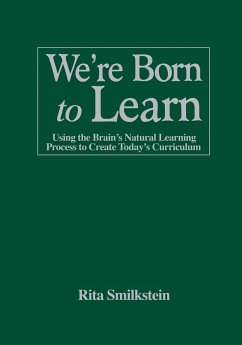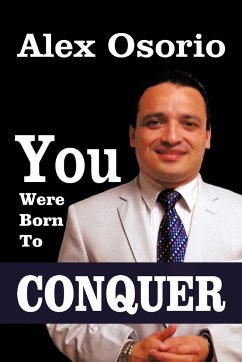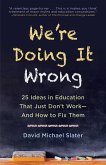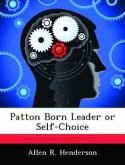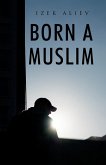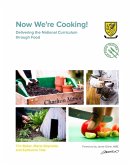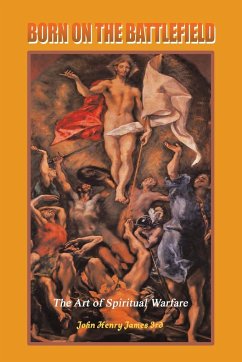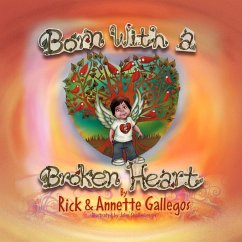Rita Smilkstein
We're Born to Learn
Using the Brain's Natural Learning Process to Create Today's Curriculum
Rita Smilkstein
We're Born to Learn
Using the Brain's Natural Learning Process to Create Today's Curriculum
- Broschiertes Buch
- Merkliste
- Auf die Merkliste
- Bewerten Bewerten
- Teilen
- Produkt teilen
- Produkterinnerung
- Produkterinnerung
Teach students to take responsibility for their own success! This updated edition of the bestselling and award-winning book on the brain's natural learning process brings new research results and applications in a power-packed teacher tool kit. Rita Smilkstein shows teachers how to create and deliver curricula that help students become the motivated, successful, and natural learners they were born to be. Updated features include: Guidelines for using the six-step Natural Human Learning Process (NHLP) for lesson planning and test preparation New information on how technology and Internet…mehr
Andere Kunden interessierten sich auch für
![You Were Born To CONQUER You Were Born To CONQUER]() Alex OsorioYou Were Born To CONQUER29,99 €
Alex OsorioYou Were Born To CONQUER29,99 €![We're Doing It Wrong: 25 Ideas in Education That Just Don't Work--And How to Fix Them We're Doing It Wrong: 25 Ideas in Education That Just Don't Work--And How to Fix Them]() David Michael SlaterWe're Doing It Wrong: 25 Ideas in Education That Just Don't Work--And How to Fix Them12,99 €
David Michael SlaterWe're Doing It Wrong: 25 Ideas in Education That Just Don't Work--And How to Fix Them12,99 €![Patton Born Leader or Self-Choice Patton Born Leader or Self-Choice]() Allen R. HendersonPatton Born Leader or Self-Choice64,99 €
Allen R. HendersonPatton Born Leader or Self-Choice64,99 €![Born a Muslim Born a Muslim]() Izek AlievBorn a Muslim15,99 €
Izek AlievBorn a Muslim15,99 €![Now We're Cooking! Now We're Cooking!]() Katharine TateNow We're Cooking!46,99 €
Katharine TateNow We're Cooking!46,99 €![Born on the Battlefield Born on the Battlefield]() John Henry James 3rdBorn on the Battlefield17,99 €
John Henry James 3rdBorn on the Battlefield17,99 €![Born With A Broken Heart Born With A Broken Heart]() Rick GallegosBorn With A Broken Heart29,99 €
Rick GallegosBorn With A Broken Heart29,99 €-
-
-
Teach students to take responsibility for their own success! This updated edition of the bestselling and award-winning book on the brain's natural learning process brings new research results and applications in a power-packed teacher tool kit. Rita Smilkstein shows teachers how to create and deliver curricula that help students become the motivated, successful, and natural learners they were born to be. Updated features include: Guidelines for using the six-step Natural Human Learning Process (NHLP) for lesson planning and test preparation New information on how technology and Internet research affect student learning Practical methods for giving all students the tools they need to achieve
Hinweis: Dieser Artikel kann nur an eine deutsche Lieferadresse ausgeliefert werden.
Hinweis: Dieser Artikel kann nur an eine deutsche Lieferadresse ausgeliefert werden.
Produktdetails
- Produktdetails
- Verlag: Corwin
- 2. Auflage
- Seitenzahl: 272
- Erscheinungstermin: 18. März 2011
- Englisch
- Abmessung: 254mm x 178mm x 15mm
- Gewicht: 518g
- ISBN-13: 9781412979382
- ISBN-10: 1412979382
- Artikelnr.: 32028318
- Herstellerkennzeichnung
- Books on Demand GmbH
- In de Tarpen 42
- 22848 Norderstedt
- info@bod.de
- 040 53433511
- Verlag: Corwin
- 2. Auflage
- Seitenzahl: 272
- Erscheinungstermin: 18. März 2011
- Englisch
- Abmessung: 254mm x 178mm x 15mm
- Gewicht: 518g
- ISBN-13: 9781412979382
- ISBN-10: 1412979382
- Artikelnr.: 32028318
- Herstellerkennzeichnung
- Books on Demand GmbH
- In de Tarpen 42
- 22848 Norderstedt
- info@bod.de
- 040 53433511
Dr. Smilkstein speaks nationally and internationally on brain-compatible education. She has taught in middle school through graduate school including 28 years at North Seattle Community College. Currently Professor Emerita North Seattle Community College and invited faculty in Educational Psychology at Western Washington University¿s Woodring College of Education, Everett Campus. Publications include articles and books on brain-based curriculum and pedagogy. Author of We're Born to Learn: Using the Brain's Natural Learning Process to Create Curriculum (Corwin Press, 2003), which won the Delta Kappa Gamma International Society's Educator's Award of the Year, 2004; the second edition will be published in 2011. She is a co-author of Igniting Student Potential Using the Natural Human Learning Process (Corwin Press, 2007). M.A. (English, Michigan State University), Ph.D. (Educational Psychology, University of Washington). She has received many teaching awards, including the National Institute for Staff and Organizational Development's Excellence Award, 1991, 1995; the College Reading and Learning Association's highest honor, the Robert Griffin Award, 2005; Induction as a Fellow of the American Council of Developmental Education Associations, 2006, the highest honor in the field of Developmental Education.
Foreword by James H. Berry
Preface
Acknowledgments
About the Author
Introduction
What This Book Is About
Why Study the Brain?
Experienced Educators and the Research
The Learning Paradigm
Assumptions
Where We Have Been
Where We Are Today
This Book
PART I: Research in the Classroom and in the Brain Lab
1. Learning and Teaching
Eye-Opening Experiences in the Classroom
The Natural Human Learning Process and Brain Research
The Breakthrough Classroom
The Research-Based Stages, Curriculum, and Lesson Plans
2. How People Learn: The Natural Human Learning Process (NHLP)
Critical and Creative Thinking by Infants and Children
An Example of Children's Critical and Creative Thinking
Critical and Creative Thinking in School
The Natural Human Learning Process and School
The Natural Human Learning Process (NHLP) Research
After the Research Is Over
Research Reports
The Importance of Making Mistakes
Where We Go From Here
3. How the Brain Learns: The Brain's Natural Learning Process
Introducing the Brain
Getting to Know the Brain
How the Brain Learns
Convergence of Ceiling Levels and Neural Networks
Pruning
Experience and Brain Growth
Constructivism
How the Brain Thinks and Remembers
The Brain's Innate Resources and Rules
Children's Brains and Adults' Brains
The Brain Grows Holistically with Plasticity
Implications for Curriculum Development
What About Piaget?
The Breakthrough Theory of Learning
4. Personal Experience, Individual Differences, and Learning
Emotions and the Brain
Negative and Positive Self-Image Networks
Learning from Experience
Learning Styles, Preferences, and Multiple Intelligences
Gifted Students
Aptitudes
Special Needs, Learning Differences, Autism, ADD, and ADHD
The Seven Magic Words: See If You Can Figure It Out
Tests
Beyond Individual Differences
A Handout for Students
5. The Student's Experience: Metacognition, Motivation, Self-Evaluation,
Achievement, and Technology Self Taught
Metacognition and Motivation
Intrinsic Rewards
Removing the Barriers
Self-Evaluation and Metacognition
Another Metacognitive Experience
Achievement
Writing Samples
Age and Achievement
Technology Self Taught
PART II: Theory and Application
6. Sequencing of the Curriculum
Challenges
The Missing Link
Two Problems
Neuroscience and Education
Converging Research
The Theory and Guide
Putting the Theory into Practice
Thinking at Higher Levels
Constructing New Knowledge
Planning the Sequence of the Units or Topics in a Curriculum
Using a Causal Sequence
Learning Activities for Units and Topics
The First Activity
Two Classroom Examples
Students and the NHLP
Developing a Curriculum
Young Students Thinking at a High Level
The NHLP in the Classroom
7. The Pedagogical Model and Guidelines
Transfer
Four Effective Instructional Practices
NHLP Pedagogical Guidelines
Assessment
Education Courses or Faculty Development Programs
Good News
PART III: Using the Brain's Natural Learning Process to Create Curriculum
8. Brain-Based, Natural Learning Across the Curriculum
The Seven Magic Words in Action
Safety
Respect
The Opportunity to Learn Naturally
The Critical First Stages
The Introduction-to-Poetry Unit
Front Loading
A Science Learning Activity about the Concept of Buoyancy
A Unit for Library Orientation
A Unit for Introduction to Safety Procedures
A Science Learning Activity about Water
A Unit for Learning How to Take Lecture Notes
The NHLP Planning Guidelines and Pedagogy
9. Curriculum Development for Units, Courses, and Programs
Where to Start
Curriculum Development Guidelines
A Unit on Literal and Inferential Meaning
A Unit on an Introduction to Egypt
A Unit on an Introduction to Fractions
A Basic Grammar Curriculum: A Sequence of Units for a Whole Course
A Developmental English Curriculum: Courses in a Program
References
General Bibliography
Index
Preface
Acknowledgments
About the Author
Introduction
What This Book Is About
Why Study the Brain?
Experienced Educators and the Research
The Learning Paradigm
Assumptions
Where We Have Been
Where We Are Today
This Book
PART I: Research in the Classroom and in the Brain Lab
1. Learning and Teaching
Eye-Opening Experiences in the Classroom
The Natural Human Learning Process and Brain Research
The Breakthrough Classroom
The Research-Based Stages, Curriculum, and Lesson Plans
2. How People Learn: The Natural Human Learning Process (NHLP)
Critical and Creative Thinking by Infants and Children
An Example of Children's Critical and Creative Thinking
Critical and Creative Thinking in School
The Natural Human Learning Process and School
The Natural Human Learning Process (NHLP) Research
After the Research Is Over
Research Reports
The Importance of Making Mistakes
Where We Go From Here
3. How the Brain Learns: The Brain's Natural Learning Process
Introducing the Brain
Getting to Know the Brain
How the Brain Learns
Convergence of Ceiling Levels and Neural Networks
Pruning
Experience and Brain Growth
Constructivism
How the Brain Thinks and Remembers
The Brain's Innate Resources and Rules
Children's Brains and Adults' Brains
The Brain Grows Holistically with Plasticity
Implications for Curriculum Development
What About Piaget?
The Breakthrough Theory of Learning
4. Personal Experience, Individual Differences, and Learning
Emotions and the Brain
Negative and Positive Self-Image Networks
Learning from Experience
Learning Styles, Preferences, and Multiple Intelligences
Gifted Students
Aptitudes
Special Needs, Learning Differences, Autism, ADD, and ADHD
The Seven Magic Words: See If You Can Figure It Out
Tests
Beyond Individual Differences
A Handout for Students
5. The Student's Experience: Metacognition, Motivation, Self-Evaluation,
Achievement, and Technology Self Taught
Metacognition and Motivation
Intrinsic Rewards
Removing the Barriers
Self-Evaluation and Metacognition
Another Metacognitive Experience
Achievement
Writing Samples
Age and Achievement
Technology Self Taught
PART II: Theory and Application
6. Sequencing of the Curriculum
Challenges
The Missing Link
Two Problems
Neuroscience and Education
Converging Research
The Theory and Guide
Putting the Theory into Practice
Thinking at Higher Levels
Constructing New Knowledge
Planning the Sequence of the Units or Topics in a Curriculum
Using a Causal Sequence
Learning Activities for Units and Topics
The First Activity
Two Classroom Examples
Students and the NHLP
Developing a Curriculum
Young Students Thinking at a High Level
The NHLP in the Classroom
7. The Pedagogical Model and Guidelines
Transfer
Four Effective Instructional Practices
NHLP Pedagogical Guidelines
Assessment
Education Courses or Faculty Development Programs
Good News
PART III: Using the Brain's Natural Learning Process to Create Curriculum
8. Brain-Based, Natural Learning Across the Curriculum
The Seven Magic Words in Action
Safety
Respect
The Opportunity to Learn Naturally
The Critical First Stages
The Introduction-to-Poetry Unit
Front Loading
A Science Learning Activity about the Concept of Buoyancy
A Unit for Library Orientation
A Unit for Introduction to Safety Procedures
A Science Learning Activity about Water
A Unit for Learning How to Take Lecture Notes
The NHLP Planning Guidelines and Pedagogy
9. Curriculum Development for Units, Courses, and Programs
Where to Start
Curriculum Development Guidelines
A Unit on Literal and Inferential Meaning
A Unit on an Introduction to Egypt
A Unit on an Introduction to Fractions
A Basic Grammar Curriculum: A Sequence of Units for a Whole Course
A Developmental English Curriculum: Courses in a Program
References
General Bibliography
Index
Foreword by James H. Berry
Preface
Acknowledgments
About the Author
Introduction
What This Book Is About
Why Study the Brain?
Experienced Educators and the Research
The Learning Paradigm
Assumptions
Where We Have Been
Where We Are Today
This Book
PART I: Research in the Classroom and in the Brain Lab
1. Learning and Teaching
Eye-Opening Experiences in the Classroom
The Natural Human Learning Process and Brain Research
The Breakthrough Classroom
The Research-Based Stages, Curriculum, and Lesson Plans
2. How People Learn: The Natural Human Learning Process (NHLP)
Critical and Creative Thinking by Infants and Children
An Example of Children's Critical and Creative Thinking
Critical and Creative Thinking in School
The Natural Human Learning Process and School
The Natural Human Learning Process (NHLP) Research
After the Research Is Over
Research Reports
The Importance of Making Mistakes
Where We Go From Here
3. How the Brain Learns: The Brain's Natural Learning Process
Introducing the Brain
Getting to Know the Brain
How the Brain Learns
Convergence of Ceiling Levels and Neural Networks
Pruning
Experience and Brain Growth
Constructivism
How the Brain Thinks and Remembers
The Brain's Innate Resources and Rules
Children's Brains and Adults' Brains
The Brain Grows Holistically with Plasticity
Implications for Curriculum Development
What About Piaget?
The Breakthrough Theory of Learning
4. Personal Experience, Individual Differences, and Learning
Emotions and the Brain
Negative and Positive Self-Image Networks
Learning from Experience
Learning Styles, Preferences, and Multiple Intelligences
Gifted Students
Aptitudes
Special Needs, Learning Differences, Autism, ADD, and ADHD
The Seven Magic Words: See If You Can Figure It Out
Tests
Beyond Individual Differences
A Handout for Students
5. The Student's Experience: Metacognition, Motivation, Self-Evaluation,
Achievement, and Technology Self Taught
Metacognition and Motivation
Intrinsic Rewards
Removing the Barriers
Self-Evaluation and Metacognition
Another Metacognitive Experience
Achievement
Writing Samples
Age and Achievement
Technology Self Taught
PART II: Theory and Application
6. Sequencing of the Curriculum
Challenges
The Missing Link
Two Problems
Neuroscience and Education
Converging Research
The Theory and Guide
Putting the Theory into Practice
Thinking at Higher Levels
Constructing New Knowledge
Planning the Sequence of the Units or Topics in a Curriculum
Using a Causal Sequence
Learning Activities for Units and Topics
The First Activity
Two Classroom Examples
Students and the NHLP
Developing a Curriculum
Young Students Thinking at a High Level
The NHLP in the Classroom
7. The Pedagogical Model and Guidelines
Transfer
Four Effective Instructional Practices
NHLP Pedagogical Guidelines
Assessment
Education Courses or Faculty Development Programs
Good News
PART III: Using the Brain's Natural Learning Process to Create Curriculum
8. Brain-Based, Natural Learning Across the Curriculum
The Seven Magic Words in Action
Safety
Respect
The Opportunity to Learn Naturally
The Critical First Stages
The Introduction-to-Poetry Unit
Front Loading
A Science Learning Activity about the Concept of Buoyancy
A Unit for Library Orientation
A Unit for Introduction to Safety Procedures
A Science Learning Activity about Water
A Unit for Learning How to Take Lecture Notes
The NHLP Planning Guidelines and Pedagogy
9. Curriculum Development for Units, Courses, and Programs
Where to Start
Curriculum Development Guidelines
A Unit on Literal and Inferential Meaning
A Unit on an Introduction to Egypt
A Unit on an Introduction to Fractions
A Basic Grammar Curriculum: A Sequence of Units for a Whole Course
A Developmental English Curriculum: Courses in a Program
References
General Bibliography
Index
Preface
Acknowledgments
About the Author
Introduction
What This Book Is About
Why Study the Brain?
Experienced Educators and the Research
The Learning Paradigm
Assumptions
Where We Have Been
Where We Are Today
This Book
PART I: Research in the Classroom and in the Brain Lab
1. Learning and Teaching
Eye-Opening Experiences in the Classroom
The Natural Human Learning Process and Brain Research
The Breakthrough Classroom
The Research-Based Stages, Curriculum, and Lesson Plans
2. How People Learn: The Natural Human Learning Process (NHLP)
Critical and Creative Thinking by Infants and Children
An Example of Children's Critical and Creative Thinking
Critical and Creative Thinking in School
The Natural Human Learning Process and School
The Natural Human Learning Process (NHLP) Research
After the Research Is Over
Research Reports
The Importance of Making Mistakes
Where We Go From Here
3. How the Brain Learns: The Brain's Natural Learning Process
Introducing the Brain
Getting to Know the Brain
How the Brain Learns
Convergence of Ceiling Levels and Neural Networks
Pruning
Experience and Brain Growth
Constructivism
How the Brain Thinks and Remembers
The Brain's Innate Resources and Rules
Children's Brains and Adults' Brains
The Brain Grows Holistically with Plasticity
Implications for Curriculum Development
What About Piaget?
The Breakthrough Theory of Learning
4. Personal Experience, Individual Differences, and Learning
Emotions and the Brain
Negative and Positive Self-Image Networks
Learning from Experience
Learning Styles, Preferences, and Multiple Intelligences
Gifted Students
Aptitudes
Special Needs, Learning Differences, Autism, ADD, and ADHD
The Seven Magic Words: See If You Can Figure It Out
Tests
Beyond Individual Differences
A Handout for Students
5. The Student's Experience: Metacognition, Motivation, Self-Evaluation,
Achievement, and Technology Self Taught
Metacognition and Motivation
Intrinsic Rewards
Removing the Barriers
Self-Evaluation and Metacognition
Another Metacognitive Experience
Achievement
Writing Samples
Age and Achievement
Technology Self Taught
PART II: Theory and Application
6. Sequencing of the Curriculum
Challenges
The Missing Link
Two Problems
Neuroscience and Education
Converging Research
The Theory and Guide
Putting the Theory into Practice
Thinking at Higher Levels
Constructing New Knowledge
Planning the Sequence of the Units or Topics in a Curriculum
Using a Causal Sequence
Learning Activities for Units and Topics
The First Activity
Two Classroom Examples
Students and the NHLP
Developing a Curriculum
Young Students Thinking at a High Level
The NHLP in the Classroom
7. The Pedagogical Model and Guidelines
Transfer
Four Effective Instructional Practices
NHLP Pedagogical Guidelines
Assessment
Education Courses or Faculty Development Programs
Good News
PART III: Using the Brain's Natural Learning Process to Create Curriculum
8. Brain-Based, Natural Learning Across the Curriculum
The Seven Magic Words in Action
Safety
Respect
The Opportunity to Learn Naturally
The Critical First Stages
The Introduction-to-Poetry Unit
Front Loading
A Science Learning Activity about the Concept of Buoyancy
A Unit for Library Orientation
A Unit for Introduction to Safety Procedures
A Science Learning Activity about Water
A Unit for Learning How to Take Lecture Notes
The NHLP Planning Guidelines and Pedagogy
9. Curriculum Development for Units, Courses, and Programs
Where to Start
Curriculum Development Guidelines
A Unit on Literal and Inferential Meaning
A Unit on an Introduction to Egypt
A Unit on an Introduction to Fractions
A Basic Grammar Curriculum: A Sequence of Units for a Whole Course
A Developmental English Curriculum: Courses in a Program
References
General Bibliography
Index

